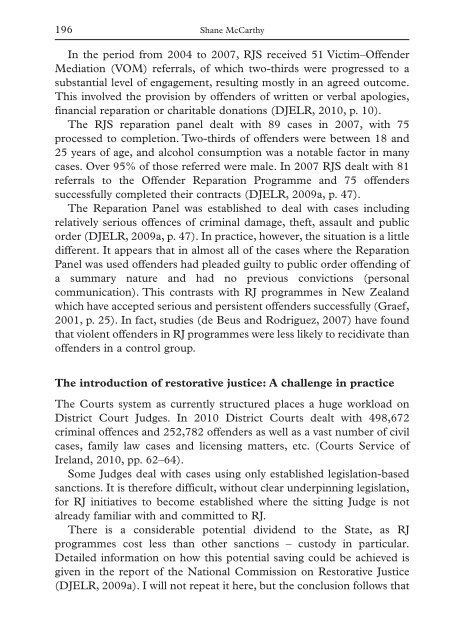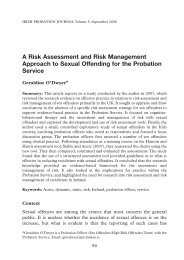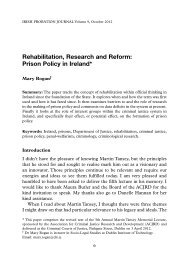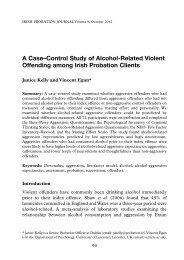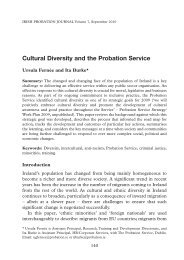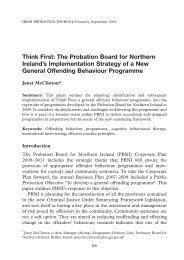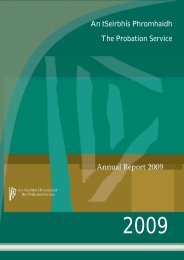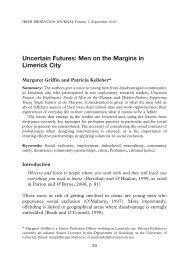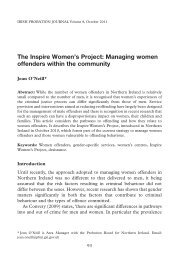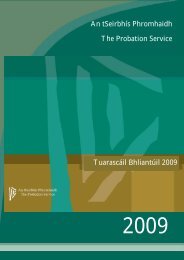Perceptions Of Restorative Justice In Ireland - The Probation Service
Perceptions Of Restorative Justice In Ireland - The Probation Service
Perceptions Of Restorative Justice In Ireland - The Probation Service
You also want an ePaper? Increase the reach of your titles
YUMPU automatically turns print PDFs into web optimized ePapers that Google loves.
196 Shane McCarthy<br />
<strong>In</strong> the period from 2004 to 2007, RJS received 51 Victim–<strong>Of</strong>fender<br />
Mediation (VOM) referrals, of which two-thirds were progressed to a<br />
substantial level of engagement, resulting mostly in an agreed outcome.<br />
This involved the provision by offenders of written or verbal apologies,<br />
financial reparation or charitable donations (DJELR, 2010, p. 10).<br />
<strong>The</strong> RJS reparation panel dealt with 89 cases in 2007, with 75<br />
processed to completion. Two-thirds of offenders were between 18 and<br />
25 years of age, and alcohol consumption was a notable factor in many<br />
cases. Over 95% of those referred were male. <strong>In</strong> 2007 RJS dealt with 81<br />
referrals to the <strong>Of</strong>fender Reparation Programme and 75 offenders<br />
successfully completed their contracts (DJELR, 2009a, p. 47).<br />
<strong>The</strong> Reparation Panel was established to deal with cases including<br />
relatively serious offences of criminal damage, theft, assault and public<br />
order (DJELR, 2009a, p. 47). <strong>In</strong> practice, however, the situation is a little<br />
different. It appears that in almost all of the cases where the Reparation<br />
Panel was used offenders had pleaded guilty to public order offending of<br />
a summary nature and had no previous convictions (personal<br />
communication). This contrasts with RJ programmes in New Zealand<br />
which have accepted serious and persistent offenders successfully (Graef,<br />
2001, p. 25). <strong>In</strong> fact, studies (de Beus and Rodriguez, 2007) have found<br />
that violent offenders in RJ programmes were less likely to recidivate than<br />
offenders in a control group.<br />
<strong>The</strong> introduction of restorative justice: A challenge in practice<br />
<strong>The</strong> Courts system as currently structured places a huge workload on<br />
District Court Judges. <strong>In</strong> 2010 District Courts dealt with 498,672<br />
criminal offences and 252,782 offenders as well as a vast number of civil<br />
cases, family law cases and licensing matters, etc. (Courts <strong>Service</strong> of<br />
<strong>Ireland</strong>, 2010, pp. 62–64).<br />
Some Judges deal with cases using only established legislation-based<br />
sanctions. It is therefore difficult, without clear underpinning legislation,<br />
for RJ initiatives to become established where the sitting Judge is not<br />
already familiar with and committed to RJ.<br />
<strong>The</strong>re is a considerable potential dividend to the State, as RJ<br />
programmes cost less than other sanctions – custody in particular.<br />
Detailed information on how this potential saving could be achieved is<br />
given in the report of the National Commission on <strong>Restorative</strong> <strong>Justice</strong><br />
(DJELR, 2009a). I will not repeat it here, but the conclusion follows that


